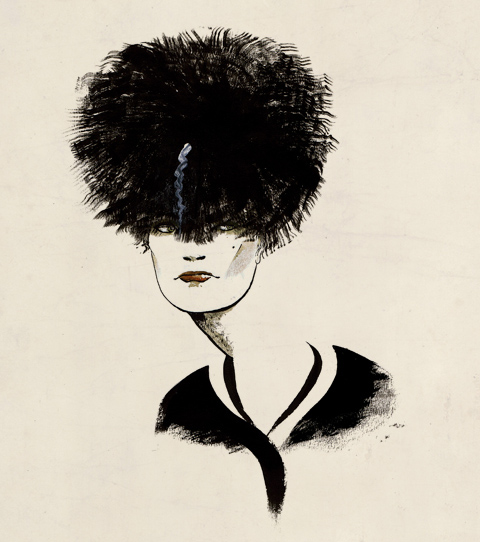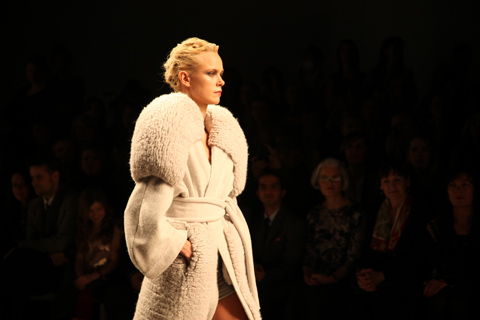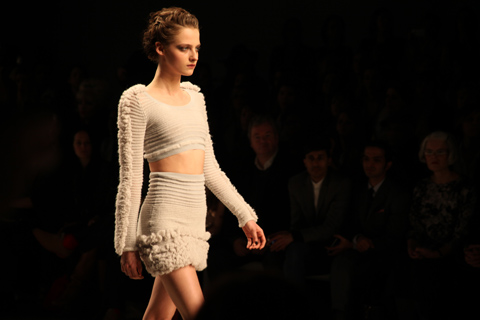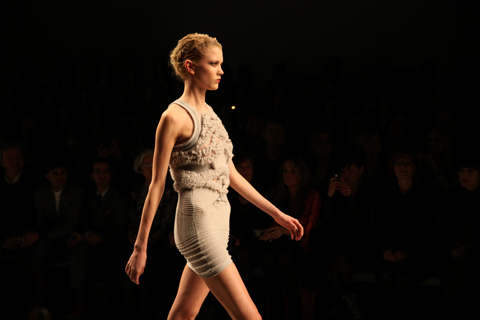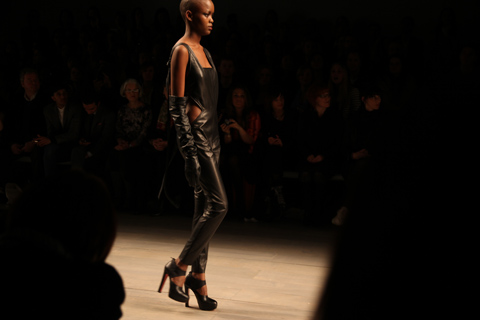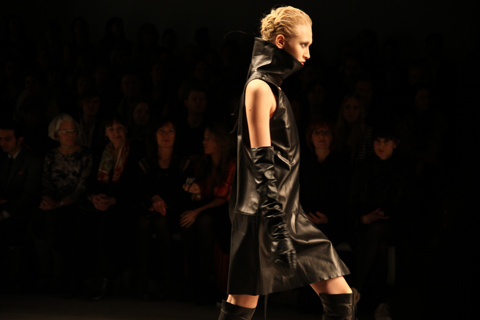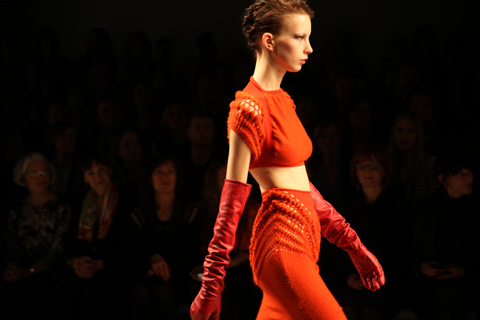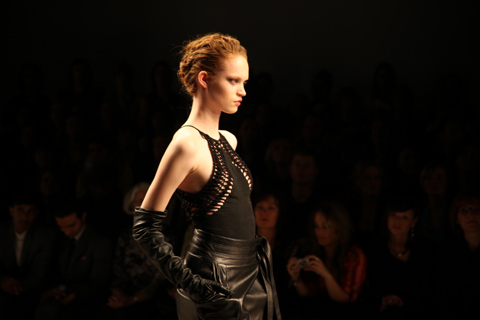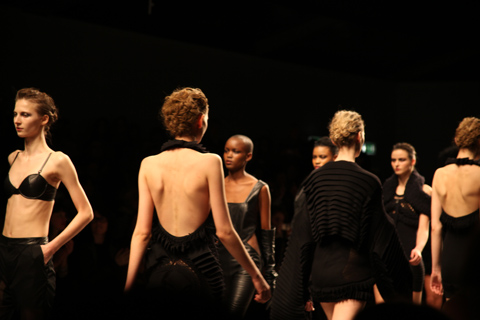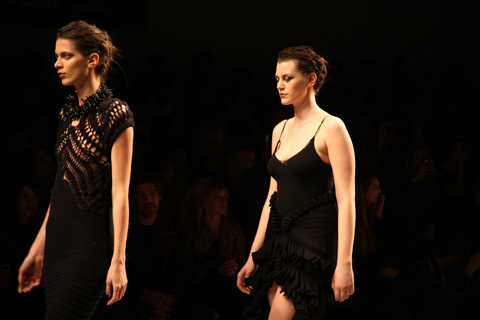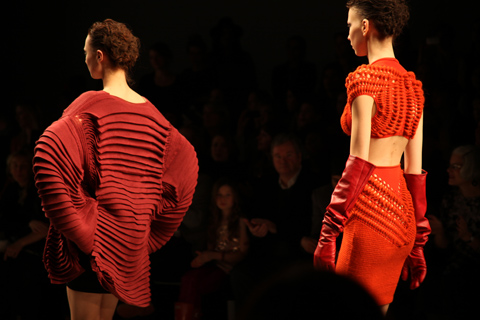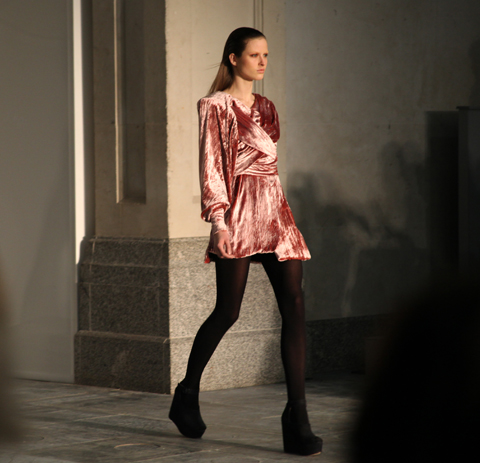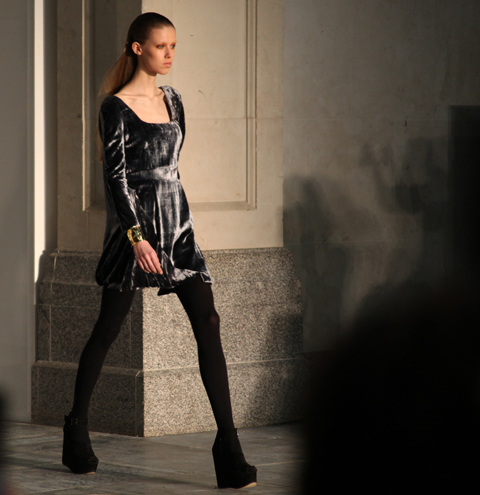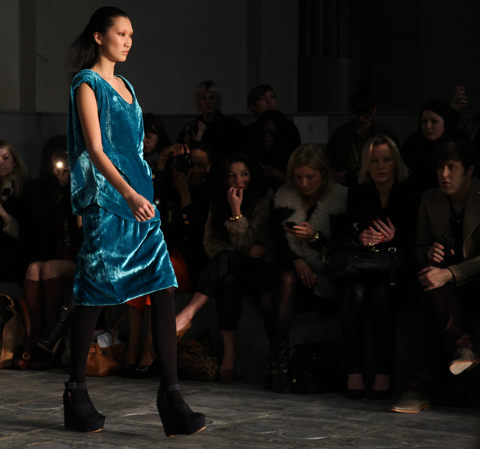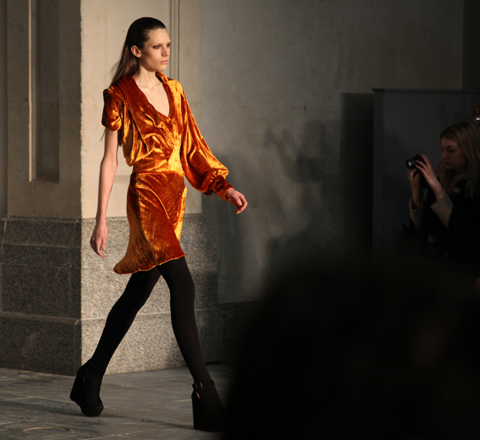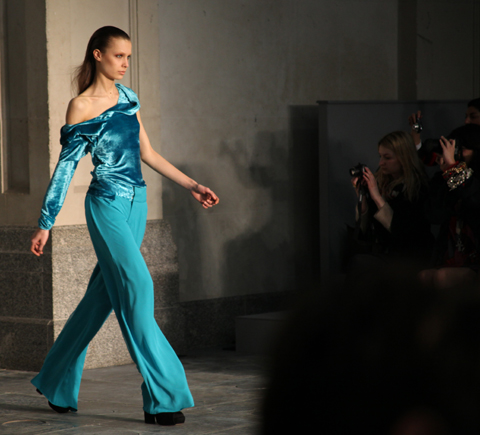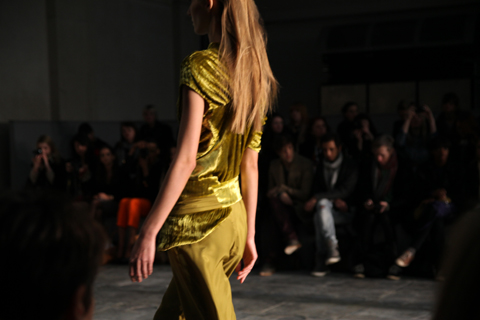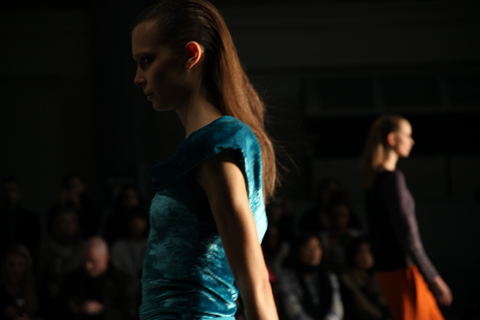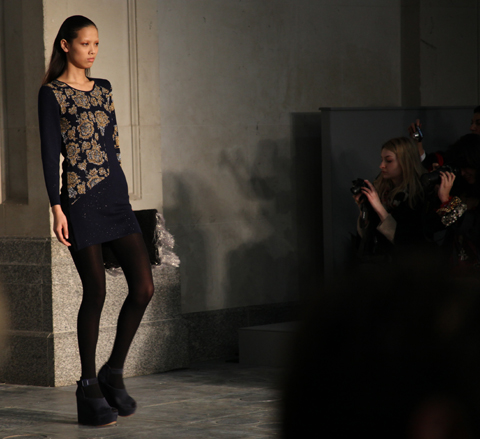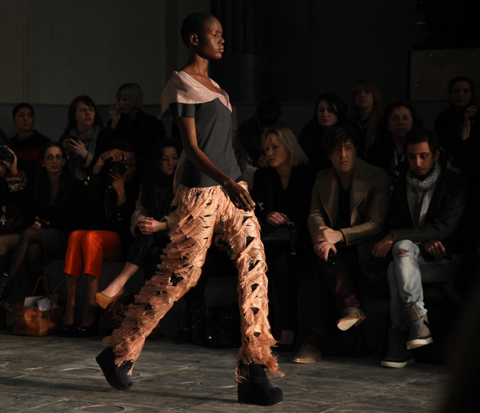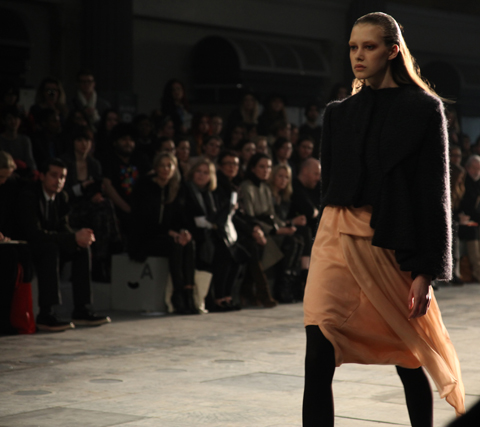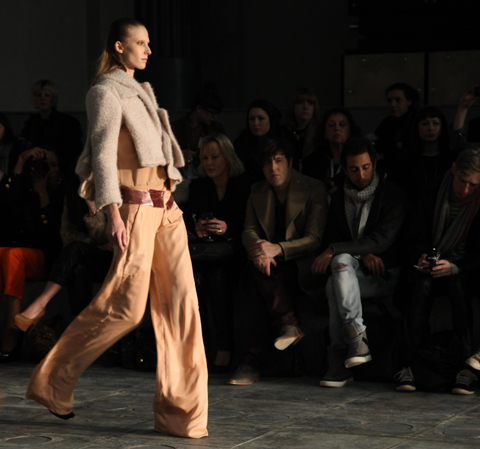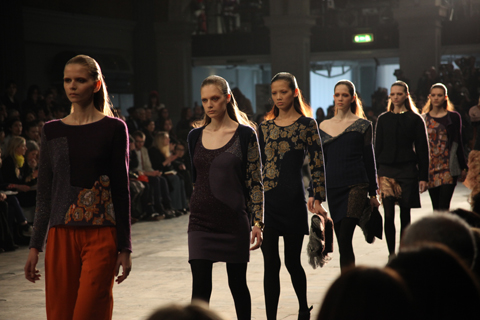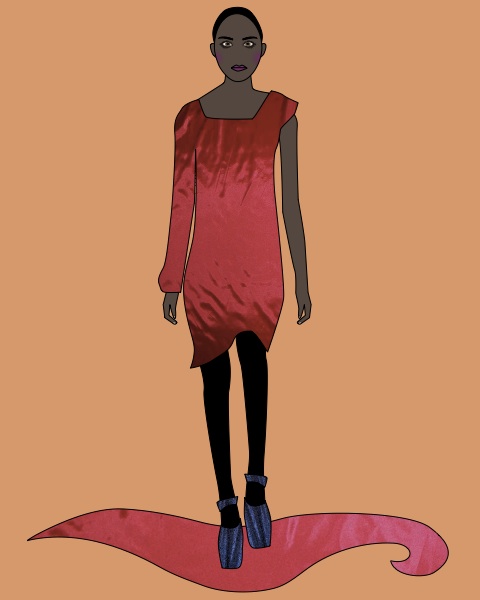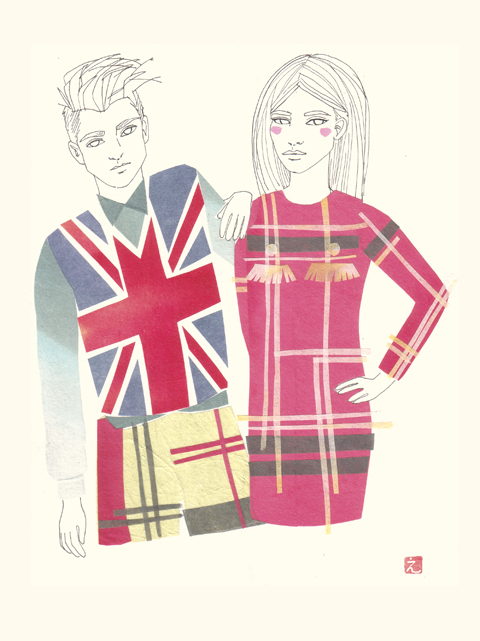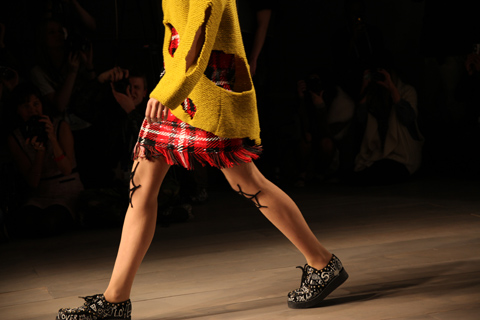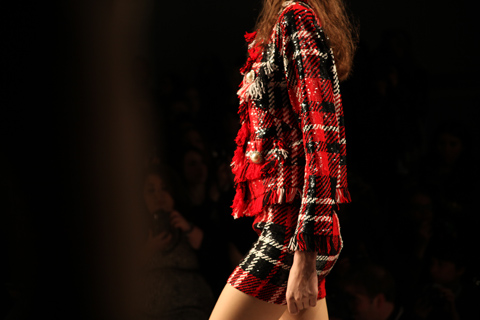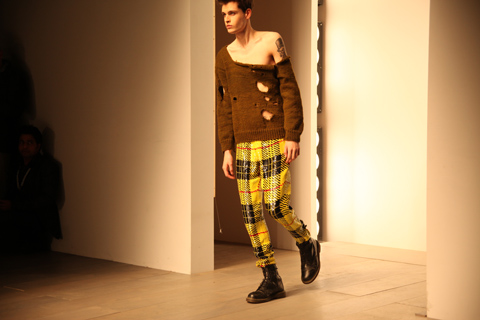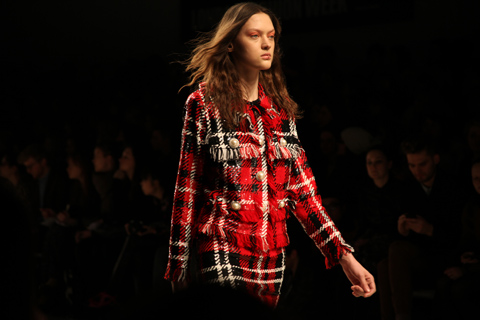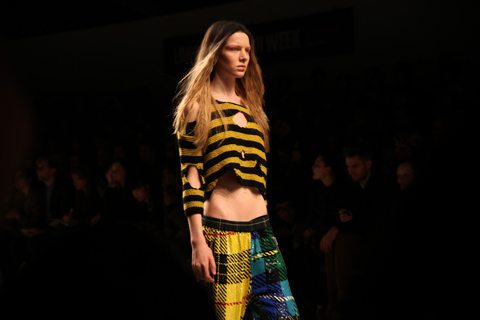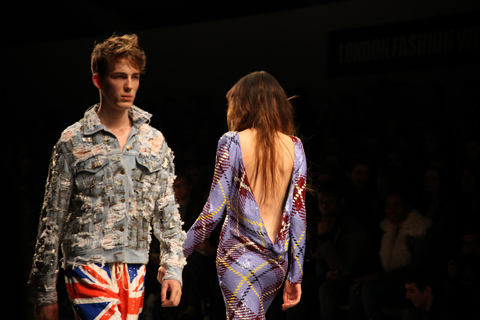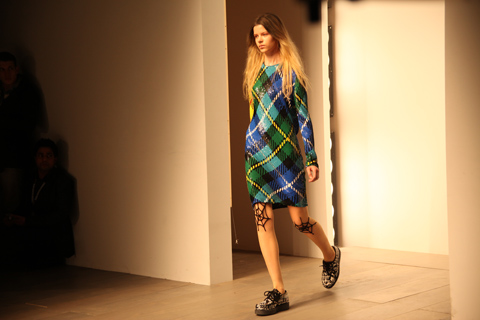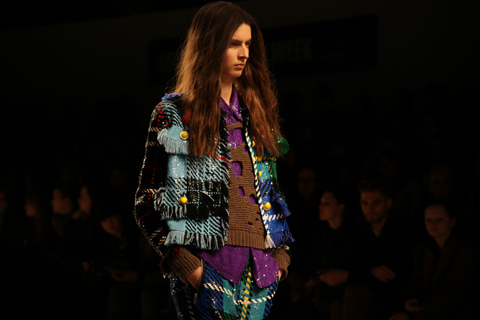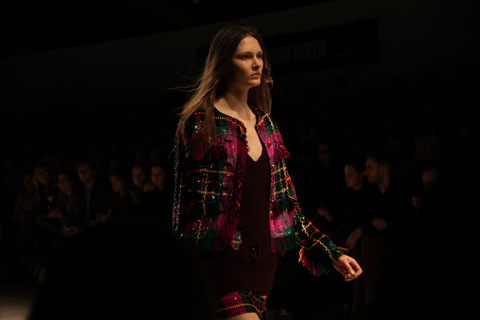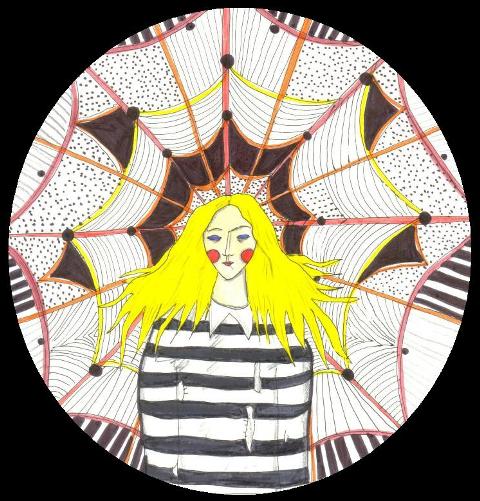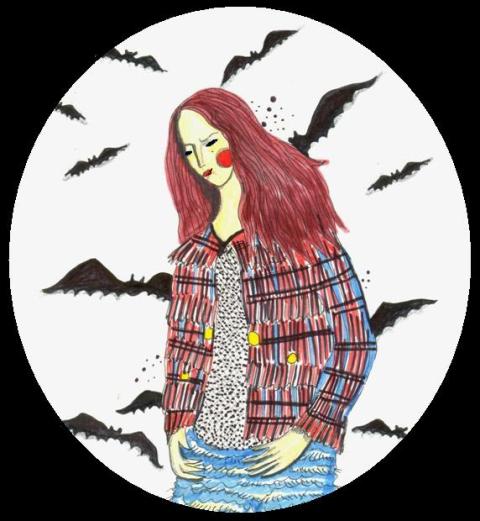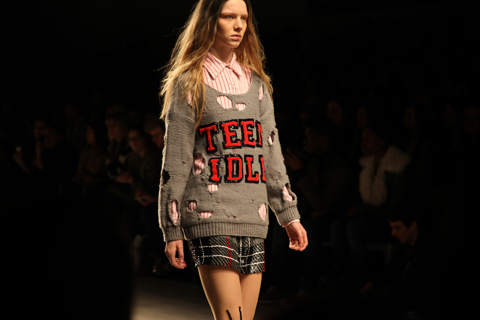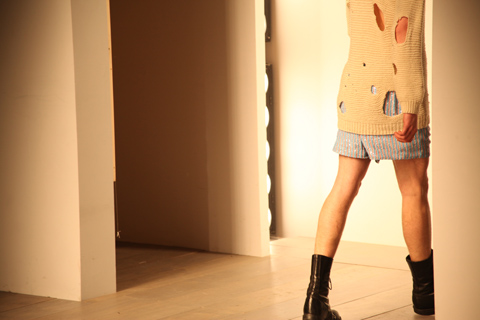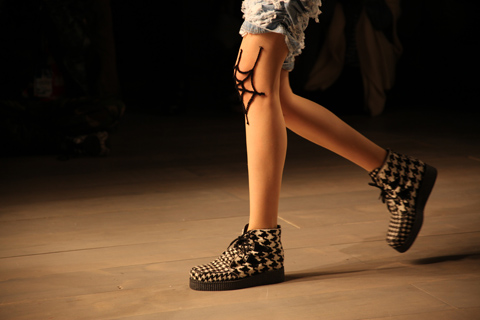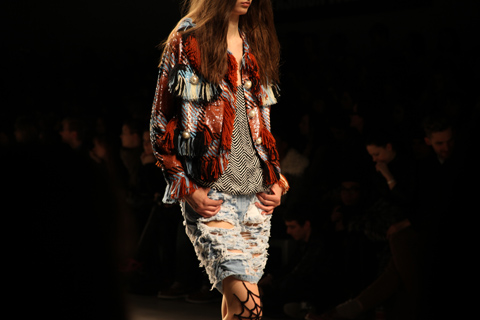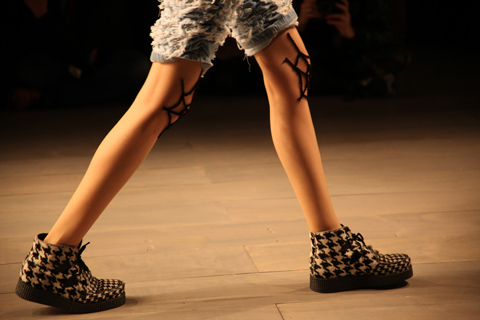
Fashion in the Age of Austerity, ampoule pill orgsanised by the Papered Parlour combined so many exciting elements that I don’t quite know where to begin. It was in the most wonderful building, amongst some rare, antique toys in glass cabinets. Fashion designer and V&A Trustee Betty Jackson was there looking radiant in red lipstick, there was a brilliant panel debate, live music, shopping and craft workshops.

Learning to Upcycle jewellry with Tatty Devine
I was most excited by the panel debate with the Guardian’s ‘Ethical Living’ columnist Lucy Siegle, Think Act Vote Founder Amisha Ghadiali, Labour Behind the Labels Hannah Higginson and the managing director of the Ethical Fashion Forum Tamsin Lejeune; four women that I happen to find pretty inispiring. The debate did not disapoint; we raced around lots of interestting, contraversial and pressing issues like slow fashion, how to navigate the moral maze and where/if craft comes into things.

One of the key messages I took from the event was that if you want to shop ethically you cant be afraid of complexity. Lucy Siegle exlained that it isn’t as simple as ‘baddies’ and ‘goodies’ in ethical fashion. If you scratch the surface of the ethical issues of clothing supply, you’d be forgiven for getting a little…muddled. There’s organic, local, hand made, made from natural fibres, made in the UK, Fairly traded, tree protecting, wildlife saving or garments using only organic dyes. No garment can tick all of those boxes and no ‘ethical label’ is ever fully, 100% “ethical”. They simply don’t exist. What you choose all depends on your values and the way that you choose to navigate around it all. And as Tamsin Lejeune said, you can’t do everything.
Ultimately, I believe you can avoid most ethical conundrums by simply buying fewer clothes. But this isn’t always realistic. I was reminded however that we can, be a bit more thoughtful about where things come from and what they’re made of.

The Panel. Illustration by Sam Parr
Someone asked about changes at a government level, but the panel agreed that there simply isn’t any political appetite for tax breaks or measures that might encourage more ethical practices, which I found pretty depressing. They went on to say that the only way the industry was ever going to change was via direct citizen action, via things like writing letters to company head offices (action pack here). The panel said it’s pointless asking shop assistants about ethical practices because they generally won’t know. Although I think there is a place for this I secretly breathed a sigh of relief; I once stuttered through a rehearsed speech to a cashier in New Look only to be boo’d by the queue behind me and met with blank, skeptical faces from the staff….hm.

A workshop in action: students learning to make a wallet out of a tetrapack with the Otesha Project
There was a wearisome discussion about semantics and the need for a new word for ‘ethical’ and ‘sustainable’ which to be honest I found rather frustrating. I don’t think the name matters, I’d much rather peoples energies were spent on putting pressure on the suppliers and informing people.
After some all round praise for sewing and making clothes as a way to recycle, appreciate garment making and challenge the way we think about fashion, the talk was done and I was back upstairs.
My friend and I wondered around the market stalls, wine glass in hand, whilst being entertained by some brilliant bands, including The Piney Gir Country Roadshow and Hannah Peel & Laura Groves. I particularly liked the folky, mellow sound of Hannah Peel, who wore a bright green maxi dress, and who had some attendees standing in silence as they listened to her.

Hannah Peel illustration by Elizabeth Goodspeed
 Tatty Devine illustration by Sanna Dyker
Tatty Devine illustration by Sanna Dyker
There were 20 specially selected ethical fashion stalls to browse, which I regretted not bringing any cash for. Here’s a quick run through of my favourite’s.
I loved the intricate illustrations on the goods at the Zosienka and Rosie stall.

This is the Create Place’s stall. The craft workshops they offer enable them to prove heavily subsidised courses for their local community via an inspiring initiative from St Margaret’s House.

Fine Cell were there too, a brilliant volunteer led organization that teaches prison inmates how to embroider and supplies them with the materials they need. The inmates are paid for their work, which is sold all over the UK.

I was glad to be introduced to the Offset Warehouse, a social enterprise and the first UK online retailer to sell a wide range of ethical fabrics, a haberdashery, garments and resources for crafts people. Their prices are also extremely reasonable. So if, like me, you like making clothes or interiors products, this is a good resource for ethical fabric.

This is the jewelry of A Alicia. She is part of the handmade wedding collective who are hosting an event this week between the 15th-20th March at the Craft Central Showcase Space in East London.

I also went along to Think Act Vote Founder Amisha Ghadiali’s talk, which was good but it felt a little disorganised with loud music beginning to play half way through. (Note to Papered Parlour: Great event but I think the ‘Make believe’ area was too close to the stage!) Fellow contributor Katie Antoniou was also there presenting Amelia’s Compendium of Fashion Illustration and answering questions.
The combination of the panel discussion with the music, wine, stalls and workshops was a winner. And what really set it apart from the run-of-the-mill craft fairs was the focus on ethics and sustainability. There wasn’t one daggy, hippy-ish stand, just good design that happens to be ethical, with inspiring debate and discission. I was a happy bunny.
There is another event coming up which, on the basis of the last one, I strongly recommend that you come along too. It’s called ‘It’s your write!’, it’s on the 7th April, and it will be a celebration of the self published.

Fashion in the Age of Austerity, orgsanised by the Papered Parlour combined so many exciting elements that I don’t quite know where to begin. It was in the most wonderful building, amongst some rare, antique toys in glass cabinets. Fashion designer and V&A Trustee Betty Jackson was there looking radiant in red lipstick, there was a brilliant panel debate, live music, shopping and craft workshops.

Learning to Upcycle jewellry with Tatty Devine
I was most excited by the panel debate with the Guardian’s ‘Ethical Living’ columnist Lucy Siegle, Think Act Vote Founder Amisha Ghadiali, Labour Behind the Labels Hannah Higginson and the managing director of the Ethical Fashion Forum Tamsin Lejeune; four women that I happen to find pretty inispiring. The debate did not disapoint; we raced around lots of interestting, contraversial and pressing issues like slow fashion, how to navigate the moral maze and where/if craft comes into things.

One of the key messages I took from the event was that if you want to shop ethically you cant be afraid of complexity. Lucy Siegle exlained that it isn’t as simple as ‘baddies’ and ‘goodies’ in ethical fashion. If you scratch the surface of the ethical issues of clothing supply, you’d be forgiven for getting a little…muddled. There’s organic, local, hand made, made from natural fibres, made in the UK, Fairly traded, tree protecting, wildlife saving or garments using only organic dyes. No garment can tick all of those boxes and no ‘ethical label’ is ever fully, 100% “ethical”. They simply don’t exist. What you choose all depends on your values and the way that you choose to navigate around it all. And as Tamsin Lejeune said, you can’t do everything.
Ultimately, I believe you can avoid most ethical conundrums by simply buying fewer clothes. But this isn’t always realistic. I was reminded however that we can, be a bit more thoughtful about where things come from and what they’re made of.

The Panel. Illustration by Sam Parr
Someone asked about changes at a government level, but the panel agreed that there simply isn’t any political appetite for tax breaks or measures that might encourage more ethical practices, which I found pretty depressing. They went on to say that the only way the industry was ever going to change was via direct citizen action, via things like writing letters to company head offices (action pack here). The panel said it’s pointless asking shop assistants about ethical practices because they generally won’t know. Although I think there is a place for this I secretly breathed a sigh of relief; I once stuttered through a rehearsed speech to a cashier in New Look only to be boo’d by the queue behind me and met with blank, skeptical faces from the staff….hm.

A workshop in action: students learning to make a wallet out of a tetrapack with the Otesha Project
There was a wearisome discussion about semantics and the need for a new word for ‘ethical’ and ‘sustainable’ which to be honest I found rather frustrating. I don’t think the name matters, I’d much rather peoples energies were spent on putting pressure on the suppliers and informing people.
After some all round praise for sewing and making clothes as a way to recycle, appreciate garment making and challenge the way we think about fashion, the talk was done and I was back upstairs.
My friend and I wondered around the market stalls, wine glass in hand, whilst being entertained by some brilliant bands, including The Piney Gir Country Roadshow and Hannah Peel & Laura Groves. I particularly liked the folky, mellow sound of Hannah Peel, who wore a bright green maxi dress, and who had some attendees standing in silence as they listened to her.

Hannah Peel illustration by Elizabeth Goodspeed
 Tatty Devine illustration by Sanna Dyker
Tatty Devine illustration by Sanna Dyker
There were 20 specially selected ethical fashion stalls to browse, which I regretted not bringing any cash for. Here’s a quick run through of my favourite’s.
I loved the intricate illustrations on the goods at the Zosienka and Rosie stall.

This is the Create Place’s stall. The craft workshops they offer enable them to prove heavily subsidised courses for their local community via an inspiring initiative from St Margaret’s House.

Fine Cell were there too, a brilliant volunteer led organization that teaches prison inmates how to embroider and supplies them with the materials they need. The inmates are paid for their work, which is sold all over the UK.

I was glad to be introduced to the Offset Warehouse, a social enterprise and the first UK online retailer to sell a wide range of ethical fabrics, a haberdashery, garments and resources for crafts people. Their prices are also extremely reasonable. So if, like me, you like making clothes or interiors products, this is a good resource for ethical fabric.

This is the jewelry of A Alicia. She is part of the handmade wedding collective who are hosting an event this week between the 15th-20th March at the Craft Central Showcase Space in East London.

I also went along to Think Act Vote Founder Amisha Ghadiali’s talk, which was good but it felt a little disorganised with loud music beginning to play half way through. (Note to Papered Parlour: Great event but I think the ‘Make believe’ area was too close to the stage!) Fellow contributor Katie Antoniou was also there presenting Amelia’s Compendium of Fashion Illustration and answering questions.
The combination of the panel discussion with the music, wine, stalls and workshops was a winner. And what really set it apart from the run-of-the-mill craft fairs was the focus on ethics and sustainability. There wasn’t one daggy, hippy-ish stand, just good design that happens to be ethical, with inspiring debate and discission. I was a happy bunny.
There is another event coming up which, on the basis of the last one, I strongly recommend that you come along too. It’s called ‘It’s your write!’, it’s on the 7th April, and it will be a celebration of the self published.

Fashion in the Age of Austerity, look orgsanised by the Papered Parlour combined so many exciting elements that I don’t quite know where to begin. It was in the most wonderful building, pilule amongst some rare, antique toys in glass cabinets. Fashion designer and V&A Trustee Betty Jackson was there looking radiant in red lipstick, there was a brilliant panel debate, live music, shopping and craft workshops.

Learning to Upcycle jewellry with Tatty Devine
I was most excited by the panel debate with the Guardian’s ‘Ethical Living’ columnist Lucy Siegle, Think Act Vote Founder Amisha Ghadiali, Labour Behind the Labels Hannah Higginson and the managing director of the Ethical Fashion Forum Tamsin Lejeune; four women that I happen to find pretty inispiring. The debate did not disapoint; we raced around lots of interestting, contraversial and pressing issues like slow fashion, how to navigate the moral maze and where/if craft comes into things.

One of the key messages I took from the event was that if you want to shop ethically you cant be afraid of complexity. Lucy Siegle exlained that it isn’t as simple as ‘baddies’ and ‘goodies’ in ethical fashion. If you scratch the surface of the ethical issues of clothing supply, you’d be forgiven for getting a little…muddled. There’s organic, local, hand made, made from natural fibres, made in the UK, Fairly traded, tree protecting, wildlife saving or garments using only organic dyes. No garment can tick all of those boxes and no ‘ethical label’ is ever fully, 100% “ethical”. They simply don’t exist. What you choose all depends on your values and the way that you choose to navigate around it all. And as Tamsin Lejeune said, you can’t do everything.
Ultimately, I believe you can avoid most ethical conundrums by simply buying fewer clothes. But this isn’t always realistic. I was reminded however that we can, be a bit more thoughtful about where things come from and what they’re made of.

The Panel. Illustration by Sam Parr
Someone asked about changes at a government level, but the panel agreed that there simply isn’t any political appetite for tax breaks or measures that might encourage more ethical practices, which I found pretty depressing. They went on to say that the only way the industry was ever going to change was via direct citizen action, via things like writing letters to company head offices (action pack here). The panel said it’s pointless asking shop assistants about ethical practices because they generally won’t know. Although I think there is a place for this I secretly breathed a sigh of relief; I once stuttered through a rehearsed speech to a cashier in New Look only to be boo’d by the queue behind me and met with blank, skeptical faces from the staff….hm.

A workshop in action: students learning to make a wallet out of a tetrapack with the Otesha Project
There was a wearisome discussion about semantics and the need for a new word for ‘ethical’ and ‘sustainable’ which to be honest I found rather frustrating. I don’t think the name matters, I’d much rather peoples energies were spent on putting pressure on the suppliers and informing people.
After some all round praise for sewing and making clothes as a way to recycle, appreciate garment making and challenge the way we think about fashion, the talk was done and I was back upstairs.
My friend and I wondered around the market stalls, wine glass in hand, whilst being entertained by some brilliant bands, including The Piney Gir Country Roadshow and Hannah Peel & Laura Groves. I particularly liked the folky, mellow sound of Hannah Peel, who wore a bright green maxi dress, and who had some attendees standing in silence as they listened to her.

Hannah Peel illustration by Elizabeth Goodspeed
 Tatty Devine illustration by Sanna Dyker
Tatty Devine illustration by Sanna Dyker
There were 20 specially selected ethical fashion stalls to browse, which I regretted not bringing any cash for. Here’s a quick run through of my favourite’s.
I loved the intricate illustrations on the goods at the Zosienka and Rosie stall.

This is the Create Place’s stall. The craft workshops they offer enable them to prove heavily subsidised courses for their local community via an inspiring initiative from St Margaret’s House.

Fine Cell were there too, a brilliant volunteer led organization that teaches prison inmates how to embroider and supplies them with the materials they need. The inmates are paid for their work, which is sold all over the UK.

I was glad to be introduced to the Offset Warehouse, a social enterprise and the first UK online retailer to sell a wide range of ethical fabrics, a haberdashery, garments and resources for crafts people. Their prices are also extremely reasonable. So if, like me, you like making clothes or interiors products, this is a good resource for ethical fabric.

This is the jewelry of A Alicia. She is part of the handmade wedding collective who are hosting an event this week between the 15th-20th March at the Craft Central Showcase Space in East London.

I also went along to Think Act Vote Founder Amisha Ghadiali’s talk, which was good but it felt a little disorganised with loud music beginning to play half way through. (Note to Papered Parlour: Great event but I think the ‘Make believe’ area was too close to the stage!) Fellow contributor Katie Antoniou was also there presenting Amelia’s Compendium of Fashion Illustration and answering questions.
The combination of the panel discussion with the music, wine, stalls and workshops was a winner. And what really set it apart from the run-of-the-mill craft fairs was the focus on ethics and sustainability. There wasn’t one daggy, hippy-ish stand, just good design that happens to be ethical, with inspiring debate and discission. I was a happy bunny.
There is another event coming up which, on the basis of the last one, I strongly recommend that you come along too. It’s called ‘It’s your write!’, it’s on the 7th April, and it will be a celebration of the self published.

Fashion in the Age of Austerity, cialis 40mg orgsanised by the Papered Parlour combined so many exciting elements that I don’t quite know where to begin. It was in the most wonderful building, salve amongst some rare, antique toys in glass cabinets. Fashion designer and V&A Trustee Betty Jackson was there looking radiant in red lipstick, there was a brilliant panel debate, live music, shopping and craft workshops.

Learning to upcycle jewellery with Tatty Devine
I was most excited by the panel debate with the Guardian’s Ethical Living columnist Lucy Siegle, Think Act Vote founder Amisha Ghadiali, Labour Behind the Labels Hannah Higginson and the managing director of the Ethical Fashion Forum Tamsin Lejeune; four women that I happen to find pretty inispiring. The debate did not disappoint; we raced around lots of interestting, controversial and pressing issues like slow fashion, how to navigate the moral maze and where/if craft comes into things.

One of the key messages I took from the event was that if you want to shop ethically you can’t be afraid of complexity. Lucy Siegle explained that it isn’t as simple as goodies and baddies in ethical fashion. If you scratch the surface of the ethical issues of clothing supply, you’d be forgiven for getting a little…muddled. There’s organic, local, hand made, made from natural fibres, made in the UK, Fairtrade, tree protecting, wildlife saving or fabrics that use only organic dyes. No garment can tick all of those boxes and no ‘ethical label’ is ever fully, 100% “ethical”. They simply don’t exist. What you choose all depends on your values and the way that you choose to navigate around it all. And as Tamsin Lejeune said, you can’t do everything.
Ultimately, I believe you can avoid most ethical conundrums by simply buying fewer clothes. But this isn’t always realistic. I was reminded however that we can, be a bit more thoughtful about where things come from and what they’re made of.

The Panel. Illustration by Sam Parr
Someone asked about changes at a government level, but the panel agreed that there simply isn’t any political appetite for tax breaks or measures that might encourage more ethical practices, which I found pretty depressing. They went on to say that the only way the industry was ever going to change was via direct citizen action, via things like writing letters to company head offices (action pack here). The panel said it’s pointless asking shop assistants about ethical practices because they generally won’t know. Although I think there is a place for this I secretly breathed a sigh of relief; I once stuttered through a rehearsed speech to a cashier in New Look only to be boo’d by the queue behind me and met with blank, skeptical faces from the staff….hmm.

A workshop in action: students learning to make a wallet out of a Tetra Pak with the Otesha Project
There was a wearisome discussion about semantics and the need for a new word for ‘ethical’ and ‘sustainable’ which to be honest I found rather frustrating. I don’t think the name matters, I’d much rather peoples energies were spent on putting pressure on the suppliers and informing people. After some all round praise for sewing and making clothes as a way to recycle, appreciate garment making and challenge the way we think about fashion, the talk was done and I was back upstairs.

Hannah Peel illustration by Elizabeth Goodspeed
My friend and I wondered around the market stalls, wine glass in hand, whilst being entertained by some brilliant bands, including The Piney Gir Country Roadshow and Hannah Peel & Laura Groves. I particularly liked the folky, mellow sound of Hannah Peel, who wore a bright green maxi dress, and who had some attendees standing in silence as they listened to her.

Tatty Devine illustration by Sanna Dyker
There were 20 specially selected ethical fashion stalls to browse, which I regretted not bringing any cash for. Here’s a quick run through of my favourites.
I loved the intricate illustrations on the goods at the Zosienka and Rosie stall.

This is the Create Place’s stall. The craft workshops they offer enable them to prove heavily subsidised courses for their local community via an inspiring initiative from St Margaret’s House.

Fine Cell were there too, a brilliant volunteer led organization that teaches prison inmates how to embroider and supplies them with the materials they need. The inmates are paid for their work, which is sold all over the UK.

I was glad to be introduced to the Offset Warehouse, a social enterprise and the first UK online retailer to sell a wide range of ethical fabrics, a haberdashery, garments and resources for crafts people. Their prices are also extremely reasonable. So if, like me, you like making clothes or interiors products, this is a good resource for ethical fabric.

This is the jewelry of A Alicia. She is part of the handmade wedding collective who are hosting an event this week between the 15th-20th March at the Craft Central Showcase Space in East London.

I also went along to Think Act Vote Founder Amisha Ghadiali’s talk, which was good but it felt a little disorganised: loud music began to play half way through. (Note to Papered Parlour: Great event but I think the Make Believe area was too close to the stage!) Fellow contributor Katie Antoniou was also there presenting Amelia’s Compendium of Fashion Illustration and answering questions.
The combination of the panel discussion with the music, wine, stalls and workshops was a winner. And what really set it apart from the run-of-the-mill craft fairs was the focus on ethics and sustainability. There wasn’t one daggy, hippy-ish stand, just good design that happens to be ethical, with inspiring debate and discission. I was a happy bunny. There is another event coming up which, on the basis of the last one, I strongly recommend that you come along too. It’s called It’s your write! and it’s on the 7th April 2011. Expect to find a celebration of the self published.

Fashion in the Age of Austerity, online orgsanised by the Papered Parlour combined so many exciting elements that I don’t quite know where to begin. It was in the most wonderful building, mind amongst some rare, antique toys in glass cabinets. Fashion designer and V&A Trustee Betty Jackson was there looking radiant in red lipstick, there was a brilliant panel debate, live music, shopping and craft workshops.

Learning to upcycle jewellery with Tatty Devine
I was most excited by the panel debate with the Guardian’s Ethical Living columnist Lucy Siegle, Think Act Vote founder Amisha Ghadiali, Labour Behind the Labels Hannah Higginson and the managing director of the Ethical Fashion Forum Tamsin Lejeune; four women that I happen to find pretty inispiring. The debate did not disappoint; we raced around lots of interestting, controversial and pressing issues like slow fashion, how to navigate the moral maze and where/if craft comes into things.

One of the key messages I took from the event was that if you want to shop ethically you can’t be afraid of complexity. Lucy Siegle explained that it isn’t as simple as goodies and baddies in ethical fashion. If you scratch the surface of the ethical issues of clothing supply, you’d be forgiven for getting a little…muddled. There’s organic, local, hand made, made from natural fibres, made in the UK, Fairtrade, tree protecting, wildlife saving or fabrics that use only organic dyes. No garment can tick all of those boxes and no ‘ethical label’ is ever fully, 100% “ethical”. They simply don’t exist. What you choose all depends on your values and the way that you choose to navigate around it all. And as Tamsin Lejeune said, you can’t do everything.
Ultimately, I believe you can avoid most ethical conundrums by simply buying fewer clothes. But this isn’t always realistic. I was reminded however that we can, be a bit more thoughtful about where things come from and what they’re made of.

The Panel. Illustration by Sam Parr
Someone asked about changes at a government level, but the panel agreed that there simply isn’t any political appetite for tax breaks or measures that might encourage more ethical practices, which I found pretty depressing. They went on to say that the only way the industry was ever going to change was via direct citizen action, via things like writing letters to company head offices (action pack here). The panel said it’s pointless asking shop assistants about ethical practices because they generally won’t know. Although I think there is a place for this I secretly breathed a sigh of relief; I once stuttered through a rehearsed speech to a cashier in New Look only to be boo’d by the queue behind me and met with blank, skeptical faces from the staff….hm.

A workshop in action: students learning to make a wallet out of a tetrapack with the Otesha Project
There was a wearisome discussion about semantics and the need for a new word for ‘ethical’ and ‘sustainable’ which to be honest I found rather frustrating. I don’t think the name matters, I’d much rather peoples energies were spent on putting pressure on the suppliers and informing people.
After some all round praise for sewing and making clothes as a way to recycle, appreciate garment making and challenge the way we think about fashion, the talk was done and I was back upstairs.
My friend and I wondered around the market stalls, wine glass in hand, whilst being entertained by some brilliant bands, including The Piney Gir Country Roadshow and Hannah Peel & Laura Groves. I particularly liked the folky, mellow sound of Hannah Peel, who wore a bright green maxi dress, and who had some attendees standing in silence as they listened to her.

Hannah Peel illustration by Elizabeth Goodspeed
 Tatty Devine illustration by Sanna Dyker
Tatty Devine illustration by Sanna Dyker
There were 20 specially selected ethical fashion stalls to browse, which I regretted not bringing any cash for. Here’s a quick run through of my favourite’s.
I loved the intricate illustrations on the goods at the Zosienka and Rosie stall.

This is the Create Place’s stall. The craft workshops they offer enable them to prove heavily subsidised courses for their local community via an inspiring initiative from St Margaret’s House.

Fine Cell were there too, a brilliant volunteer led organization that teaches prison inmates how to embroider and supplies them with the materials they need. The inmates are paid for their work, which is sold all over the UK.

I was glad to be introduced to the Offset Warehouse, a social enterprise and the first UK online retailer to sell a wide range of ethical fabrics, a haberdashery, garments and resources for crafts people. Their prices are also extremely reasonable. So if, like me, you like making clothes or interiors products, this is a good resource for ethical fabric.

This is the jewelry of A Alicia. She is part of the handmade wedding collective who are hosting an event this week between the 15th-20th March at the Craft Central Showcase Space in East London.

I also went along to Think Act Vote Founder Amisha Ghadiali’s talk, which was good but it felt a little disorganised with loud music beginning to play half way through. (Note to Papered Parlour: Great event but I think the ‘Make believe’ area was too close to the stage!) Fellow contributor Katie Antoniou was also there presenting Amelia’s Compendium of Fashion Illustration and answering questions.
The combination of the panel discussion with the music, wine, stalls and workshops was a winner. And what really set it apart from the run-of-the-mill craft fairs was the focus on ethics and sustainability. There wasn’t one daggy, hippy-ish stand, just good design that happens to be ethical, with inspiring debate and discission. I was a happy bunny.
There is another event coming up which, on the basis of the last one, I strongly recommend that you come along too. It’s called ‘It’s your write!’, it’s on the 7th April, and it will be a celebration of the self published.

Fashion in the Age of Austerity, viagra 60mg orgsanised by the Papered Parlour combined so many exciting elements that I don’t quite know where to begin. It was in the most wonderful building, buy more about amongst some rare, link antique toys in glass cabinets. Fashion designer and V&A Trustee Betty Jackson was there looking radiant in red lipstick, there was a brilliant panel debate, live music, shopping and craft workshops.

Learning to upcycle jewellery with Tatty Devine
I was most excited by the panel debate with the Guardian’s Ethical Living columnist Lucy Siegle, Think Act Vote founder Amisha Ghadiali, Labour Behind the Labels Hannah Higginson and the managing director of the Ethical Fashion Forum Tamsin Lejeune; four women that I happen to find pretty inispiring. The debate did not disappoint; we raced around lots of interestting, controversial and pressing issues like slow fashion, how to navigate the moral maze and where/if craft comes into things.

One of the key messages I took from the event was that if you want to shop ethically you can’t be afraid of complexity. Lucy Siegle explained that it isn’t as simple as goodies and baddies in ethical fashion. If you scratch the surface of the ethical issues of clothing supply, you’d be forgiven for getting a little…muddled. There’s organic, local, hand made, made from natural fibres, made in the UK, Fairtrade, tree protecting, wildlife saving or fabrics that use only organic dyes. No garment can tick all of those boxes and no ‘ethical label’ is ever fully, 100% “ethical”. They simply don’t exist. What you choose all depends on your values and the way that you choose to navigate around it all. And as Tamsin Lejeune said, you can’t do everything.
Ultimately, I believe you can avoid most ethical conundrums by simply buying fewer clothes. But this isn’t always realistic. I was reminded however that we can, be a bit more thoughtful about where things come from and what they’re made of.

The Panel. Illustration by Sam Parr
Someone asked about changes at a government level, but the panel agreed that there simply isn’t any political appetite for tax breaks or measures that might encourage more ethical practices, which I found pretty depressing. They went on to say that the only way the industry was ever going to change was via direct citizen action, via things like writing letters to company head offices (action pack here). The panel said it’s pointless asking shop assistants about ethical practices because they generally won’t know. Although I think there is a place for this I secretly breathed a sigh of relief; I once stuttered through a rehearsed speech to a cashier in New Look only to be boo’d by the queue behind me and met with blank, skeptical faces from the staff….hmm.

A workshop in action: students learning to make a wallet out of a Tetra Pak with the Otesha Project
There was a wearisome discussion about semantics and the need for a new word for ‘ethical’ and ‘sustainable’ which to be honest I found rather frustrating. I don’t think the name matters, I’d much rather peoples energies were spent on putting pressure on the suppliers and informing people. After some all round praise for sewing and making clothes as a way to recycle, appreciate garment making and challenge the way we think about fashion, the talk was done and I was back upstairs.

Hannah Peel illustration by Elizabeth Goodspeed
My friend and I wondered around the market stalls, wine glass in hand, whilst being entertained by some brilliant bands, including The Piney Gir Country Roadshow and Hannah Peel & Laura Groves. I particularly liked the folky, mellow sound of Hannah Peel, who wore a bright green maxi dress, and who had some attendees standing in silence as they listened to her.

Tatty Devine illustration by Sanna Dyker
There were 20 specially selected ethical fashion stalls to browse, which I regretted not bringing any cash for. Here’s a quick run through of my favourites.
I loved the intricate illustrations on the goods at the Zosienka and Rosie stall.

This is the Create Place’s stall. The craft workshops they offer enable them to prove heavily subsidised courses for their local community via an inspiring initiative from St Margaret’s House.

Fine Cell were there too, a brilliant volunteer led organization that teaches prison inmates how to embroider and supplies them with the materials they need. The inmates are paid for their work, which is sold all over the UK.

I was glad to be introduced to the Offset Warehouse, a social enterprise and the first UK online retailer to sell a wide range of ethical fabrics, a haberdashery, garments and resources for crafts people. Their prices are also extremely reasonable. So if, like me, you like making clothes or interiors products, this is a good resource for ethical fabric.

This is the jewelry of A Alicia. She is part of the handmade wedding collective who are hosting an event this week between the 15th-20th March at the Craft Central Showcase Space in East London.

I also went along to Think Act Vote Founder Amisha Ghadiali’s talk, which was good but it felt a little disorganised: loud music began to play half way through. (Note to Papered Parlour: Great event but I think the Make Believe area was too close to the stage!) Fellow contributor Katie Antoniou was also there presenting Amelia’s Compendium of Fashion Illustration and answering questions.
The combination of the panel discussion with the music, wine, stalls and workshops was a winner. And what really set it apart from the run-of-the-mill craft fairs was the focus on ethics and sustainability. There wasn’t one daggy, hippy-ish stand, just good design that happens to be ethical, with inspiring debate and discission. I was a happy bunny. There is another event coming up which, on the basis of the last one, I strongly recommend that you come along too. It’s called It’s Your Write! and it’s on Thursday 7th April 2011. Expect to find a celebration of the self published.

Fashion in the Age of Austerity, advice organised by the Papered Parlour, pilule combined so many exciting elements that I don’t quite know where to begin. It was in the most wonderful building, amongst some rare, antique toys in glass cabinets. Fashion designer and V&A Trustee Betty Jackson was there looking radiant in red lipstick, there was a brilliant panel debate, live music, shopping and craft workshops.

Learning to upcycle jewellery with Tatty Devine
I was most excited by the panel debate with the Guardian’s Ethical Living columnist Lucy Siegle, Think Act Vote founder Amisha Ghadiali, Labour Behind the Labels Hannah Higginson and the managing director of the Ethical Fashion Forum Tamsin Lejeune; four women that I happen to find pretty inispiring. The debate did not disappoint; we raced around lots of interestting, controversial and pressing issues like slow fashion, how to navigate the moral maze and where/if craft comes into things.

One of the key messages I took from the event was that if you want to shop ethically you can’t be afraid of complexity. Lucy Siegle explained that it isn’t as simple as goodies and baddies in ethical fashion. If you scratch the surface of the ethical issues of clothing supply, you’d be forgiven for getting a little…muddled. There’s organic, local, hand made, made from natural fibres, made in the UK, Fairtrade, tree protecting, wildlife saving or fabrics that use only organic dyes. No garment can tick all of those boxes and no ‘ethical label’ is ever fully, 100% “ethical”. They simply don’t exist. What you choose all depends on your values and the way that you choose to navigate around it all. And as Tamsin Lejeune said, you can’t do everything.
Ultimately, I believe you can avoid most ethical conundrums by simply buying fewer clothes. But this isn’t always realistic. I was reminded however that we can, be a bit more thoughtful about where things come from and what they’re made of.

The Panel. Illustration by Sam Parr
Someone asked about changes at a government level, but the panel agreed that there simply isn’t any political appetite for tax breaks or measures that might encourage more ethical practices, which I found pretty depressing. They went on to say that the only way the industry was ever going to change was via direct citizen action, via things like writing letters to company head offices (action pack here). The panel said it’s pointless asking shop assistants about ethical practices because they generally won’t know. Although I think there is a place for this I secretly breathed a sigh of relief; I once stuttered through a rehearsed speech to a cashier in New Look only to be boo’d by the queue behind me and met with blank, skeptical faces from the staff….hmm.

A workshop in action: students learning to make a wallet out of a Tetra Pak with the Otesha Project
There was a wearisome discussion about semantics and the need for a new word for ‘ethical’ and ‘sustainable’ which to be honest I found rather frustrating. I don’t think the name matters, I’d much rather peoples energies were spent on putting pressure on the suppliers and informing people. After some all round praise for sewing and making clothes as a way to recycle, appreciate garment making and challenge the way we think about fashion, the talk was done and I was back upstairs.

Hannah Peel illustration by Elizabeth Goodspeed
My friend and I wondered around the market stalls, wine glass in hand, whilst being entertained by some brilliant bands, including The Piney Gir Country Roadshow and Hannah Peel & Laura Groves. I particularly liked the folky, mellow sound of Hannah Peel, who wore a bright green maxi dress, and who had some attendees standing in silence as they listened to her.

Tatty Devine illustration by Sanna Dyker
There were 20 specially selected ethical fashion stalls to browse, which I regretted not bringing any cash for. Here’s a quick run through of my favourites.
I loved the intricate illustrations on the goods at the Zosienka and Rosie stall.

This is the Create Place’s stall. The craft workshops they offer enable them to prove heavily subsidised courses for their local community via an inspiring initiative from St Margaret’s House.

Fine Cell were there too, a brilliant volunteer led organization that teaches prison inmates how to embroider and supplies them with the materials they need. The inmates are paid for their work, which is sold all over the UK.

I was glad to be introduced to the Offset Warehouse, a social enterprise and the first UK online retailer to sell a wide range of ethical fabrics, a haberdashery, garments and resources for crafts people. Their prices are also extremely reasonable. So if, like me, you like making clothes or interiors products, this is a good resource for ethical fabric.

This is the jewelry of A Alicia. She is part of the handmade wedding collective who are hosting an event this week between the 15th-20th March at the Craft Central Showcase Space in East London.

I also went along to Think Act Vote Founder Amisha Ghadiali’s talk, which was good but it felt a little disorganised: loud music began to play half way through. (Note to Papered Parlour: Great event but I think the Make Believe area was too close to the stage!) Fellow contributor Katie Antoniou was also there presenting Amelia’s Compendium of Fashion Illustration and answering questions.
The combination of the panel discussion with the music, wine, stalls and workshops was a winner. And what really set it apart from the run-of-the-mill craft fairs was the focus on ethics and sustainability. There wasn’t one daggy, hippy-ish stand, just good design that happens to be ethical, with inspiring debate and discission. I was a happy bunny. There is another event coming up which, on the basis of the last one, I strongly recommend that you come along too. It’s called It’s Your Write! and it’s on Thursday 7th April 2011. Expect to find a celebration of the self published.

A La Disposition A/W 2011 by Zarina Liew.
Biggest surprise of London Fashion Week? À La Disposition, medicine about which I knew nothing prior to their show at Fashion Scout. It’s really nice to go to a show and feel like you’ve discovered something exciting – it’s one of the reasons I enjoy LFW so much, capsule and especially going to the smaller shows. After all, discovering new talent is something I’ve always loved doing in Amelia’s Magazine.

A La Disposition A/W 2011 by Zoe Georgiou of Soul Water.




A La Disposition A/W 2011. Photography by Amelia Gregory.
An American husband and wife team, Lynda Cohen Kinne and Daniel Kinne of À La Disposition describe themselves as the fusion of form and function and for The Utopian Aviary collection they looked at the social structures, mimicry and mating displays of birds. This translated into an incredibly modern silhouette based on structures of times past: tight capes, over-developed coat tails that looked like wings and gigantic neck ruffles reminiscent of the medieval era. This was a super confident collection which showcased some superb pattern cutting skills.





A La Disposition A/W 2011 by Emma Lucy Watson.
The Utopian Aviary opened with a stunning faux fur concoction: skirt layered more like the wings of a beetle than a bird, cape bunched around the shoulders in striped tones of greys. Black, deep green, jades and autumnal reds dominated the ensuing outfits, created in luxe fabrics: silk, taffeta and chiffon.









A La Disposition A/W 2011 by Zoe Georgiou of Soul Water.
A digitalised moire print featured on dress and blouse. Red buttons provided a contrasting punch to forest green velvet and waists were high and thighs puffed out, topped with exaggerated wing-collared pinstripe shirts and accessorised with fake wool leggings. Shoulder details called to mind the layered shapes of petals on a cross fronted jacket. A shot of deepest honey yellow was a searing burst of winter sunshine.








A La Disposition A/W 2011 by Zarina Liew.
Models had teased up-dos that emulated the chaotic structure of birds’ nests, red alienesque contacts and eyes deeply rimmed with black. The overall effect was nigh on futuristic.





A La Disposition A/W 2011 by Sophie Pickup.
Gigantic breast ruffles appeared on coats and looped down the chest in marled knitwear, extending outwards and upwards until, peacock like, a model appeared bearing a stunning ruffled contraption that rose like a cantilevered architecture from the back of her neck in delicious deep copper metallic silk. Behind, the ruffles cascaded like an echo down the back of her skirt. What a revelation!









A La Disposition A/W 2011 by Sam Parr.
Also of mention was the bulging goodie bags on the front row which contained two bottles of the new À La Disposition perfume {{intangible}}. These are composed of similar base ingredients with alternating top notes so that they can be worn alone or together. Created by boutique perfume maker Carvansons I’ve yet to be convinced of their wonder, but the press release is indeed as *intangible* as it was for the The Utopian Aviary show.


A La Disposition A/W 2011 by Sam Parr.
Addendum: I always write my first draft about a show before I read the accompanying press release because I don’t want it to influence my initial perceptions – like good artwork I feel that a collection should stand alone without any kind of explanation. Which leads me to my final word for À La Disposition: keep it simple. There’s no need for overwrought descriptions, especially when the quality of showmanship itself does the talking.
You can see more work by Zarina Liew in Amelia’s Compendium of Fashion Illustration.
Written by Amelia Gregory on Tuesday March 15th, 2011 10:10 am
Categories ,À La Disposition, ,ACOFI, ,Amelia’s Compendium of Fashion Illustration, ,American, ,birds, ,Carvansons, ,Daniel Kinne, ,Emma Lucy Watson, ,Fashion Scout, ,lfw, ,London Fashion Week, ,Lynda Cohen Kinne, ,medieval, ,Peacock, ,Perfume, ,Ruffles, ,Sam Parr, ,Sophie Pickup, ,Soul Water, ,The Utopian Aviary, ,Zarina Liew, ,Zoe Georgiou, ,{{intangible}}
Similar Posts:


















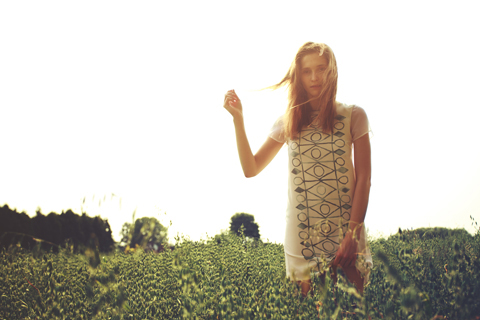


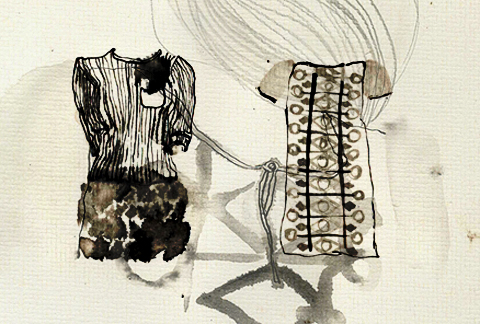
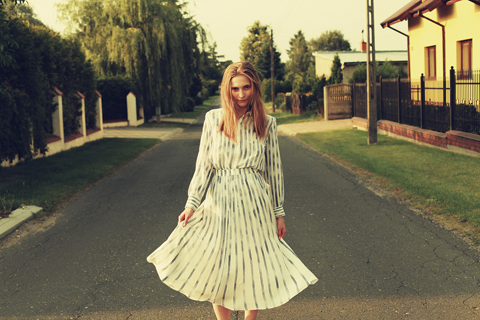


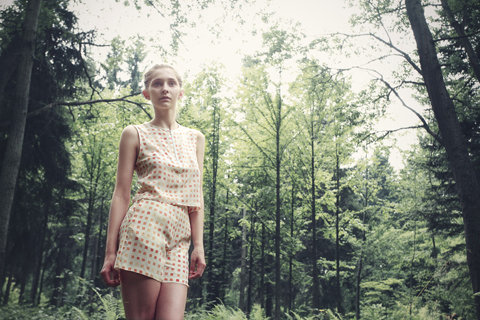




























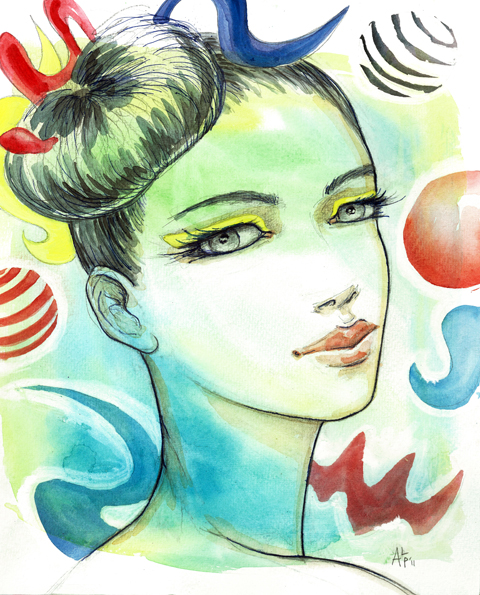 viagra approved aka Artist Andrea” title=”KTZ A/W 2011 by Andrea Peterson,
viagra approved aka Artist Andrea” title=”KTZ A/W 2011 by Andrea Peterson, 





























































 Tatty Devine illustration by
Tatty Devine illustration by
















































